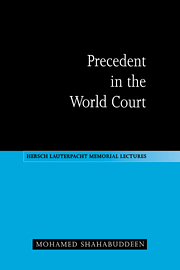Book contents
- Frontmatter
- Contents
- Foreword
- Preface
- List of abbreviations
- 1 Introduction
- 2 The growth of the Court's case law
- 3 Range of precedential resources
- 4 The bases of the system
- 5 The Advisory Committee of Jurists
- 6 The view taken by the League of Nations
- 7 The possibility of judge-made international law
- 8 Stare decisis
- 9 Distinguishing
- 10 Departing from a previous decision
- 11 Ratio decidendi and obiter dictum
- 12 Advisory opinions and decisions of chambers
- 13 The precedential impact of individual opinions
- 14 Effect and scope of the Court's case law
- 15 Conclusion
- Index
6 - The view taken by the League of Nations
Published online by Cambridge University Press: 04 May 2010
- Frontmatter
- Contents
- Foreword
- Preface
- List of abbreviations
- 1 Introduction
- 2 The growth of the Court's case law
- 3 Range of precedential resources
- 4 The bases of the system
- 5 The Advisory Committee of Jurists
- 6 The view taken by the League of Nations
- 7 The possibility of judge-made international law
- 8 Stare decisis
- 9 Distinguishing
- 10 Departing from a previous decision
- 11 Ratio decidendi and obiter dictum
- 12 Advisory opinions and decisions of chambers
- 13 The precedential impact of individual opinions
- 14 Effect and scope of the Court's case law
- 15 Conclusion
- Index
Summary
Introductory remarks
Whatever the position taken in the Advisory Committee of Jurists on the question whether decisions of the Court could lead to the creation of new law, it is clear that the understanding of the Council of the League of Nations, by which the draft Statute was amended, and of the Assembly, by which it was ultimately adopted (with further amendments), was that decisions of the Court could at least affect the development of international law.
In considering the positions taken by the League of Nations and by the Advisory Committee of Jurists, it is right to bear in mind that, as was pointed out by M. Léon Bourgeois, the members of the Committee were all jurists. Hence, ‘in purely technical matters’ their views would command greater respect than those of the Council and the Assembly of the League of Nations, not all of whom were lawyers. But this does not suffice to outweigh the consideration that the substantive decisions were made by the Council and the Assembly of the League. This is relevant in view of different currents of thinking implicit in the material presented to the Advisory Committee of Jurists.
The right of intervention
It is difficult to understand the view taken by some delegates on the right of intervention except on the basis that they assumed, and assumed correctly, that the decisions of the Court could affect the development of international law.
- Type
- Chapter
- Information
- Precedent in the World Court , pp. 55 - 66Publisher: Cambridge University PressPrint publication year: 1996



